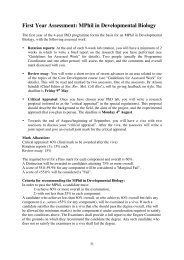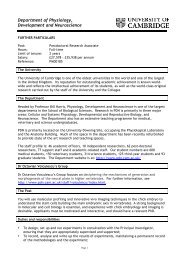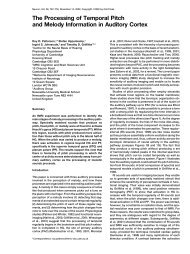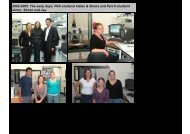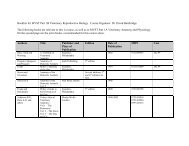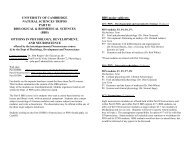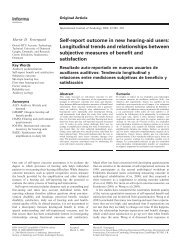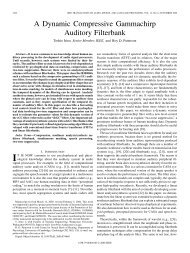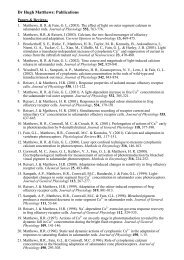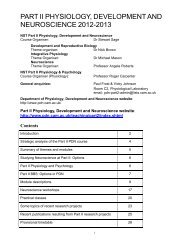FRIDAY MORNING, 20 MAY 2005 REGENCY E, 8:30 A.M. TO 12:00 ...
FRIDAY MORNING, 20 MAY 2005 REGENCY E, 8:30 A.M. TO 12:00 ...
FRIDAY MORNING, 20 MAY 2005 REGENCY E, 8:30 A.M. TO 12:00 ...
Create successful ePaper yourself
Turn your PDF publications into a flip-book with our unique Google optimized e-Paper software.
for statistical characterization of noise environments, since these methods<br />
may allow generalization of the model to a wider range of real-world noise<br />
environments. Work sponsored by Department of Fisheries and Oceans<br />
Canada.<br />
5aSC9. Predicting speech intelligibility in real-world noise<br />
environments from functional measures of hearing. Christian<br />
Giguère, Chantal Laroche, Véronique Vaillancourt Univ. of Ottawa, 451<br />
Smyth Rd., Ottawa, ON, K1H 8M5, Canada, and Sigfrid Soli House Ear<br />
Inst., Los Angeles, CA 9<strong>00</strong>57<br />
In everyday life situations and in many occupational settings, speech<br />
communication is often performed in noisy environments. These environments<br />
can sometimes be very challenging, particularly for individuals impaired<br />
by hearing loss. Diagnostic measures of hearing, such as the audiogram,<br />
are not adequate to make accurate predictions of speech<br />
intelligibility in real-world noise environments. Instead, a direct functional<br />
measure of hearing, the Hearing In Noise Test HINT, has been identified<br />
and validated for use in predicting speech intelligibility in a wide range of<br />
face-to-face speech communication situations in real-world noise environments.<br />
The prediction approach takes into account the voice level of the<br />
talker in noise due to the Lombard effect, the communication distance<br />
between the talker and the listener, a statistical model of speech perception<br />
in specific noises, and the functional hearing abilities of the listener. The<br />
latter is taken as the elevation of the individual’s speech reception threshold<br />
in noise above the normative value for the HINT test. This test is<br />
available in several languages, so that language-specific needs can be addressed.<br />
The detailed approach will be presented with an emphasis placed<br />
on application examples in clinical and/or occupational settings.<br />
5aSC10. Perceptual, acoustic, and tongue shape measures during ÕrÕ<br />
production pre- and post-treatment using visual feedback from<br />
ultrasound: case studies of two adolescents. Marcy Adler-Bock,<br />
Barbara Bernhardt, Penelope Bacsfalvi Dept. of Audiol. and Speech Sci.,<br />
Univ. of British Columbia, 5804 Fairview Ave., Vancouver, BC, V6T 1Z3,<br />
and Bryan Gick Univ. of British Columbia, Vancouver, BC, Canada V6T<br />
1Z1<br />
This study examined the effectiveness of using visual feedback from<br />
ultrasound in remediation of persistent /r/ errors. Ultrasound provided the<br />
participants and the clinician with a dynamic sagittal or coronal image of<br />
the tongue during speech production. The participants in this study were<br />
two adolescent boys ages <strong>12</strong> and 14 who were not able to produce an<br />
on-target North American /r/. Both participants had received at least one<br />
year of traditional /r/ therapy without improvement. Treatment was provided<br />
over 13 one-hour sessions using visual feedback from ultrasound.<br />
Initially, /r/ was broken down and rehearsed as individual motor targets<br />
tongue tip, body, root; these components were then practiced in combination<br />
to produce /r/ in isolation, then in syllables, words, and phrases.<br />
Post-treatment changes in /r/ production were captured through transcription,<br />
acoustic analysis, and tongue shape measurement. Both participants<br />
/r/ productions were rated as having more tokens of on-target /r/ posttreatment.<br />
Acoustic results supported these findings with the third formant<br />
lowering post-treatment. Tongue shape measures indicated that the participants<br />
tongue shapes were more similar to the modeled /r/ tongue shape<br />
post-treatment. These case studies suggest that visual feedback as provided<br />
by ultrasound may be a useful adjunct to speech rehabilitation.<br />
5aSC11. The influence of severity of speech involvement on acoustic<br />
measures in dysarthria. Yunjung Kim, Gary Weismer, and Ray D. Kent<br />
Dept. of Communicative Disord. and Waisman Ctr., Univ. of<br />
Wisconsin-Madison, Madison, WI 53705<br />
Several different acoustic measures have described the articulatory<br />
deficit and predicted the overall speech intelligibility deficit in speakers<br />
with dysarthria. The articulatory basis of acoustic variables that predict<br />
speech intelligibility variations across speakers have been thought to be<br />
the ones that should be manipulated clinically for maximum therapeutic<br />
effect. For example, F2 extent and slope are known to have strong correlations<br />
with speech intelligibility measures, across dysarthric speakers.<br />
This may suggest that within-speaker manipulation of magnitude and/or<br />
speed of articulatory movements will, if successful, result in improved<br />
speech intelligibility. Some of our previous work Weismer et al., <strong>20</strong>01,<br />
Folia Phoniat. Logopaed. indicates, however, that these measures may not<br />
be predictive of within-speaker fluctuations in intelligibility, but rather are<br />
indices only of across-speaker variation in severity. The large data base of<br />
dysarthric speakers at UW-Madison permits us to begin to determine how<br />
much variability exists for measures like F2 slope in a relatively large<br />
group of speakers with homogeneous speech severity. This paper will<br />
report results of F2 extent and slope measures for speakers with relatively<br />
mild speech involvement. If the measures are primarily tied to severity,<br />
they should not vary much within a homogeneous group of speakers.<br />
Work supported by DC<strong>00</strong>319.<br />
5aSC<strong>12</strong>. Variability of jaw movement in contrastive stress production<br />
of children with and without speech delay of unknown origin. Jennell<br />
C. Vick, Lakshmi Venkatesh, and Christopher A. Moore Dept. of Speech<br />
and Hearing Sci., Univ. of Washington, Seattle, WA 98101<br />
This study was designed to evaluate the control of jaw movement in<br />
contrastive stress productions of children with and without speech delay.<br />
The spatiotemporal index STI was used to calculate variability in jaw<br />
movement trajectories in <strong>12</strong> children producing three different metrical<br />
forms of CVCV syllables trochaic, iambic, and even stress; papa, mama,<br />
and baba. The children mean age: 3;2 years were categorized, four in<br />
each of three groups, as having Normal Speech Acquisition NSA,<br />
Speech Delay SD, or both NSA/SD using the Speech Disorder Classification<br />
System Shriberg et al., 1997. Results replicated findings in typically<br />
developing children of a similar age reported by Goffman and Malin<br />
1999 where iambic forms were produced with greater stability than trochaic<br />
forms as measured by the STI. Analysis using a repeated measures<br />
ANOVA revealed significant effects for contrastive stress type, speech<br />
disorder classification, and syllable identity. Results are reported in the<br />
context of vowel acoustic measures of contrastive stress. Work supported<br />
by NIDCD R01 DC <strong>00</strong><strong>00</strong>822-10.<br />
5aSC13. Articulatory movements during vowels produced by<br />
speakers with dysarthria and normal controls. Yana Yunusova, John<br />
Westbury, and Gary Weismer Dept. of Commun. Disord. and Waisman<br />
Ctr., Univ. of Wisconson–Madison, 15<strong>00</strong> Highland Ave., Madison, WI<br />
53705<br />
The central goal of the study was to provide a quantitative description<br />
of contributions of the jaw, lower lip, tongue blade and tongue dorsum to<br />
vowel productions, and to determine patterns of interarticulatory interactions<br />
between movements. Kinematic and acoustic signals were collected<br />
using the x-ray microbeam. Thirty-four speakers, <strong>12</strong> with dysarthria due to<br />
Parkinson disease, 7 with amyotrophic lateral sclerosis, and 15 normal<br />
controls, were recorded reading sentences at a comfortable speech rate.<br />
Ten CVC words, each containing one of the English vowels /i,I,u,a,ae,o/<br />
carrying primary stress, were selected for analysis. Each fleshpoint trajectory<br />
was characterized by marker positions at vowel onset and offset, and<br />
the moment when speed was lowest. Measures of distance traveled, time<br />
to and from the moment of minimum speed, and peak and average movement<br />
speed were employed. Movement characteristics, and associations<br />
between movements, were compared for different vowels, contexts, speakers<br />
and groups. Results are reported for vowels and vowel groups e.g., lax<br />
versus tense, averaged separately by contexts for speaker groups. The<br />
data speak to previous claims that speakers with dysarthria exhibit evidence<br />
of discoordination in speech movements relative to normal performance.<br />
Work supported by NIDCD Award R01 DC<strong>00</strong>3723.<br />
5a FRI. AM<br />
2605 J. Acoust. Soc. Am., Vol. 117, No. 4, Pt. 2, April <strong>20</strong>05 149th Meeting: Acoustical Society of America 2605



